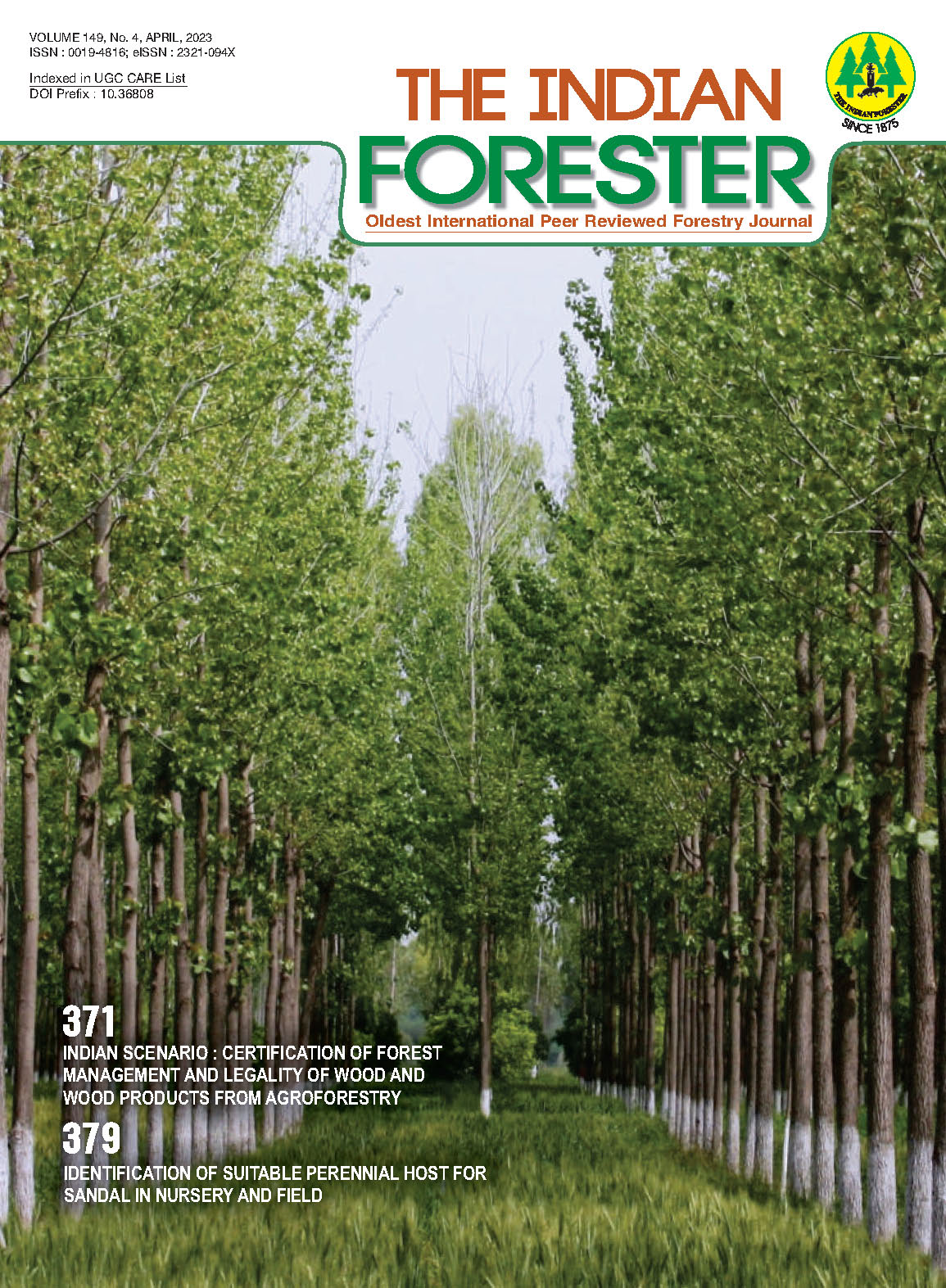Agroforestry and Organic Farming Scope in India towards Net Zero
DOI:
https://doi.org/10.36808/if/2023/v149i4/168882Keywords:
Agroforestry, Carbon, Climate, Organic, Sacred Groves.Abstract
Net zero emissions goals, recently accepted globally, provide huge scope for vigorous agroforestry growth to increase India's tree cover in 10 years from 25% of country's land area to 33% by 2030. However, agroforestry may be able to meet 25% of the ambitious target of 2.5-billion-ton CO2 equivalent offset pledged by India by then. Forestry is already carbon +ve sector but can absorb more carbon by promoting selective forest tree felling to trigger young trees growth. Green buildings code and certified timber initiative can help in it and need to be promoted rather than “hands-off†forestry. Organic farming practices can sequester double this amount of carbon if promoted countrywide. Sacred groves i.e. forest patches dedicated to deity provide traditional vistas of balancing conservation and utility as depicted here with a case study from Pune district. Their declaration as “heritage sites†under The Biological Diversity Act, 2002 can help in their future sustenance.References
Anantha K.C., Majumder S.P., Badole S., Shrikant Badole, Dhaneshwar Pradhan, Ashim Datta and Biswapat Mandal (2020). Pools of organic carbon in soils under a long-term rice–rice system with different organic amendments. Carbon Management, 11(4): 331-339.
Ashutosh S., Sharma S., Lakhchaura P., Ghosh S., Tripathi S. and Uniyal M.( 2019). India's Nationally Determined Contribution of Creating an Additional Carbon Sink of 2.5 to 3 billion tonnes of CO2 eq through Additional Forest & Tree Cover: Possibilities, Scale & Costs for Formulating Strategy. Forest Survey of India, Dehradun, Technical Information Series, I(3): 54.
Anon (n.d).https://preferredbynature.org/ newsroom/green-building-key-driver-timber certification.
Anon. (2011). https://niti.gov.in/planningcommission.gov.in/docs/aboutus/committee/wrkgrp12/enf/ wg_subntfp.pdf.
BBC (1998). "India: The Economy". 12 February.
FSI (2017). India's State of Forest Report. Forest Survey of India, Dehradun.
FSI (2019). India's State of Forest Report. Forest Survey of India, Dehradun.
FSI (2021). India's State of Forest Report. Forest Survey of India, Dehradun.
Gadgil M. and Vartak V.D. (1975). Sacred groves of India: Aplea for continued conservation. Journal of Bombay Natural History Society, 72: 314–320.
Ghate U., Patwardhan A. and Waran A. (2005). Reduced urban consumerism and enhanced rural bio-enterprises for food, Water & Climatic Security. Curr. Sci., 88(2): 213-214.
Joshi Meenakshi and Preet Pal Singh (2003). Carbon sequestration by rehabilitating degraded forests in India. FAO, Rome. https://www.fao.org/3/XII/0405-B2.htm.
Kant P. and Nautiyal R. (2020). India timber supply & demand, 2010-2030. International Tropical Timber Organisation, P. 57.
Kaul M., Mohren G.M.J. and Dadhwal V.K. (2010). Carbon storage and sequestration potential of selected tree species in India. Mitig Adapt Strateg Glob Change, 15: 489–510.
Kumar D.P.J. (2014). Western Ghats Conservation: Experts' Reports and a View from the ground. Economic and Political Weekly, 49(29), 19 July, 2014
Lal R. (2004 c). Soil carbon sequestration in India. Climatic Change, 65: 277-296.
Malhotra K.C., Gokhale Y. and Das K. (2001). Sacred Groves Of India : An Annotated Bibliography. Indian Natl. Sc. Academy and Development Alliance, New Delhi.
Mathur A., Sharma J., Subhash A. and Priyanka (2021). Will India attain its forestry NDC target of achieving 2.5–3 billion ton of Co2 equivalent through additional forest and tree cover by 2030? The Energy and Resources Institute (TERI), New Delhi. P. 17.
Melkania N.P. (2009). Carbon sequestration in Indian natural and planted forests. Indian Forester, 135(3): 380-391.
Pandey D.N. (2002). Global climate change and carbon managementin multifunctional forests.Curr.Sci.,83(5):593-602.
Patwardhan A., Ghate P., Mhaskar M. and Bansude A. (2021). Cultural dimensions of sacred forests in the Western Ghats Biodiversity Hot Spot, Southern India and its implications for biodiversity protection. International Journal of Anthropology and Ethnology, 5: 12 pp. 26.
Ravindranath N.H., Somashekhar B.S. and Gadgil M. (1997). Carbon flow in Indian forests. Climatic Change, 35: 297–320.
Rizvi R.H., Dhyani S.K. and Yadav R.S., et al. (2011). Biomass production and carbon stock of poplar agroforestry systems in Yamunanagar and Saharanpur districts of northwestern India. Curr. Sci., 100(5): 736-742.
Singh A., Unnikrishnan S. and Naik N. et al. (2013). Role of India's forests in climate change mitigation through the CDM and REDD+ Jr. Environment. Plan. Management, 56(1): 61–87.
Tiefenbacher A., Sandén T. and Haslmayr H. et al. (2021). Optimizing Carbon Sequestration in Croplands: A Synthesis. Agronomy., 11: 882.pp. 28.
UNEP (n.d.), For a livable climate: Net-zero commitments must be backed by credible action. https://www.un.org/en/climatechange/net-zero-coalition.
Downloads
Downloads
Additional Files
Published
How to Cite
Issue
Section
License
Unless otherwise stated, copyright or similar rights in all materials presented on the site, including graphical images, are owned by Indian Forester.





